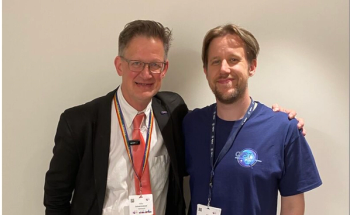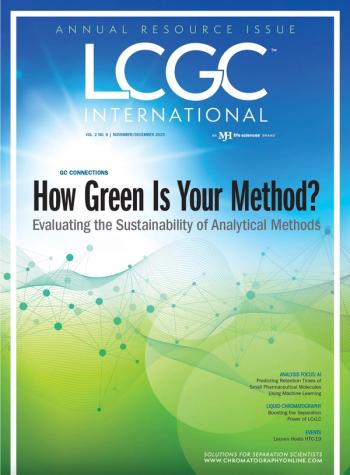
HPLC 2015 Wednesday Afternoon Sessions
HPLC 2015 Wednesday Afternoon Sessions
Session 31: Microseparation
Room 1, Level 1
14:00 - Amy Herr: Precision Microfluidic Design Advances Targeted Proteomics to Single Cell Resolution
14:30 - Mirek Macka: Portable Capillary LC as a Flexible Design Modular System Based on a Microfluidic Platform and Designed with Off-the-Shelf Components
14:50 - Brett Paul: 3D-Printed Titanium Capillary Columns with Internal Monoliths
15:10 - Takuya Kubo: Specific Separations by a C60-Fullerene Bonded Silica-Monolithic Capillary in Liquid Chromatography
Session 32: Proteomics
Room 2, Level 0
14:00 - William Hancock: The Role of HPLC/MS Analysis in the Study of Cancer Associated Changes in Glycan Motifs
14:30 -Hartmut Schlüter: Protein Extraction for Proteomics by Cold Vaporization of Tissues
14:50 - Marcel Kwiatkowski: Downscaling of 2D-LC for Bottom-Up Proteomics by Applying Displacement Chromatography
15:10 -Steven Ray Wilson: Open Tubular Enzyme Reactors and Separation Columns for Accelerated and Sensitive Proteomics
Session 33: Metabolomics
Room 3 + 4, Level 0
14:00 - Guowang Xu: Stable Isotope Labeled Metabolic Profiling Analysis
14:30 -Rawi Ramautar: Probing a New Volume Regime in Metabolomics with Sheathless Capillary Electrophoresis-Mass Spectrometry
14:50 -Serge Rudaz: Steroidomic Footprinting Based on UHPLC Qualitative and Quantitative High-Resolution MS for the Evaluation of Endocrine Disrupting Chemicals in H295R cells
15:10 - Maria Grübner: Systematic Development of Powerful Two-Dimensional Separation Systems for Metabolomic Studies
Tutorial 07
Room 5 + 6, Level 3
14:30 - Monika Dittman: The Impact of Extra-Column Contributions on the Performance of High-Efficiency UHPLC Columns
Session 34: Separation
Room 1, Level 1
16:15 - Edward Yeung: Determination of sterols using liquid chromatography with off-line substrate-assisted laser desorption/ionization mass spectrometry
16:45 - Jiri Urban: Towards Multifunctional Monolithic Capillary Device: Sample Focusing, Separation, and Electrochemical Detection of Neurotransmitters in One Single Capillary
17:05 - Ivo Nischang: Porous Polymer Monoliths: Fundamental Structure, Mass-Transport, and Emerging Opportunities
17:25 - Estrella Sanz Rodriguez: Capillary Ion Chromatography with On-Column Focusing for Ultra-Trace Analysis of Organic and Inorganic Species in Volume-Limited Antarctic Ice-Core Samples
Session 35: Bioanalysis
Room 2, Level 0
16:15 - Nico van de Merbel: Quantitative Bioanalysis by LC–MS–MS: From Small to Large Molecules
16:45 -Elin Follaug Johnsen: Highly Automated Platform for Simultaneous Identification of All Classes of Neurotransmitters by Hydrophilic Interaction Liquid Chromatography–MS
17:05 -Jolien Van Schoors: Analytical Advances for Challenging In vivo Neurochemical Measurements
17:25 - Marianne Fillet: Dried Spot Sampling for Hepcidin Quantitation in Human Blood by Microfluidic LC–MS–MS: Comparison of DBS and VAMS for Matrix Effect and Extraction Recovery
Session 36: Young Scientists
Room 3 + 4, Level 0
David Geissler: Microchip Electrophoresis with Two-Photon Excited Label-Free Deep-UV Fluorescence Detection in Full-Body Polymeric Microfluidic Devices
Marco Nestola: Universal Route to Polycyclic Aromatic Hydrocarbons in Foodstuff: Two-Dimensional Heart-Cut Liquid Chromatography / Gas Chromatography – Mass Spectrometry
Ivo Nischang: Radical-Mediated Step-Growth in the Preparation of Monolithic Columns: A Fundamental Rationale for Its Choice and Experimental Evidence of Its Success
Jonathan Sidibé: Biotransformation Monitoring of Monoclonal Antibodies in Plasma Using Immuno-Extraction Coupled to Liquid Chromatography High Resolution Mass Spectrometry
Rocchina Sabia: Temperature Dependent Separation and Determination of Enantiomerization Barrier of the Interconverting Enantiomers of Benzodiazepines
Stella Fasoula: Modeling of solute retention and separation optimization procedures for research and educational purposes in HPLC with Microsoft Excel Macros
Sam Wouters: Design and Characterization of a Modular Microfluidic Platform for Ion Chromatography with Suppressed Conductivity Detection
James Grinias: 5 μm Superficially Porous Particles for Use in Capillary and Microfluidic LC
Annamária Sepsey: Molecular Dynamic Theory of “Batman” Peaks: Enantiomer Separation Using the Stochastic Theory of Chromatography
Kyoko Watanabe: Dual UHPLC-SRM/MS Column-Switching System with Fast Polarity Switching for the Quantification of Endogenous Metabolites in Human Samples
Tiffany Porta: The Potential in Preclinical and Clinical Research for Online and High-Resolution Liquid Extraction Surface Analysis NanoLC-MS/MS
Tutorial 08
Room 5 + 6, Level 3
16:45 - Valérie Pichon: Antibodies, Aptamers and Imprinted Polymers as Selective tools for the Trace Analysis of Target Analytes in Complex Samples
Newsletter
Join the global community of analytical scientists who trust LCGC for insights on the latest techniques, trends, and expert solutions in chromatography.



